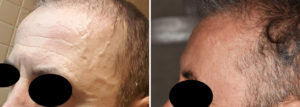While the superficial temporal artery, a distal branch of the external carotid artery, is essential for providing blood flow to the temples and scalp. Based on its path northward into the scalp, it appears to be the terminal end of the external carotid artery. It splits in a well known Y-configuration above the ear of which the frontal branch heads toward the forehead in a tortuous and usually multiply branches pattern.
The superficial temporal artery is associated with several medical pathologies including giant cell arteritis and migraine headaches for which pharmacologic and surgical treatments exist. Its lone aesthetic pathology is that of an undue prominence. In some men (and even rarely in women) the frontal branch pattern becomes very pronounced. This appears as ‘ropes’ of dilated arteries coursing up and across the forehead. It may appear on just one side but more often than not is a bilateral problem.
The cause of prominent temporal arteries is not exactly known but its preponderance in men indicate a hormonal influence with more thick muscular walls that are prone to stimulation from heat, alcohol, certain drugs and exercise. Injectable therapies, such as fillers and fat, have been used in an effort to camouflage them, but this is not usually a very successful strategy.

Each temporal side requires 3 or 4 ligations points that must be carefully mapped out before doing the procedure. Success is determined by the elimination of pulsatile flow through the prominent vessels. This intraoperative end point will produce a completely satisfying aesthetic result in a one time procedure in approximately 80% of treated patients. Additional ligations may be secondarily needed for recurrent branches that usually represent unseen feeders at the time of initial surgery.
Dr. Barry Eppley
Indianapolis, Indiana


